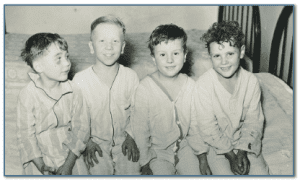Thoughts from the Archives – Highlights from 100 Years
In the following piece, our OHB historian, John Carter, briefly runs through some of the highlights of our first 100 years:
Our Home is three months into our 100th year of operation so maybe it’s time to review some of the highlights since we were incorporated in October 1920.

Our first location was a home on the northwest corner of 22nd and Davenport Streets near downtown and our first resident was James King. Within two years we moved to larger quarters, a lovely mansion at 2137 S 33rd Street donated by the Megeath family.
To support Omaha Home for Boys on a sustained basis an annual fundraising campaign was started among the Masonic lodges in 1926. Hundreds of campaign workers would jam in the meeting hall on campaign nights in the Masonic building downtown to report their success in securing contributions. The annual maintenance campaign still carries on each fall but in much smaller numbers than originally seen.
In 1930 a farm four miles north of Elkhorn, Nebraska was purchased. The idea was to raise food for the Home at the Megeath House on 33rd Street and maybe, just maybe, build a second campus for up to 200 boys and girls said Tinley Combs, our longtime president. But muddy roads hampered transportation and the local school system could not handle an influx of 200 students. The Elkhorn farm was sold in 1941 and the proceeds were used to purchase a 59-acre farm northwest of Omaha. If you drive by 20906 Rainwood Road north of Elkhorn today, you’ll see that the old farm is still largely intact and the driveway’s pillars with their Masonic identifications still stand.
Following a survey of other childrens’ homes it was decided to build several residential cottages rather than one large dormitory on the new property in North Omaha. After a capital campaign was undertaken in the early 1940s construction began on the first three cottages even though it was difficult to get building supplies during wartime.

The big day came in July 1945 when the 50 boys from the Megeath home were bussed to their new homes on 52nd and Ames Streets. The old Megeath home, half a century old and having endured 22 years of 60 youngsters under one roof was sold to a neighboring church and was soon demolished for a school and a playground.
In 1950 local cattleman Bob Cooper donated a 72-acre stock farm three miles north of the Omaha campus for the development of a 4H program. This led to the development of the Valley View 4H Club, still going strong as Nebraska’s oldest 4H club.
In 1952 our name was changed from the Omaha Masonic Home for Boys to the Omaha Home for Boys because funds cannot be solicited Masonically across state lines, and the growing Home with many new brick buildings on two large campuses was in dire need to increase its financial base.
A nationwide direct mail program was started in the early 1950s and Christmas seals started to be used in 1955.
The Home, now with a fairly new location, a new name and an expanded fundraising source, settled into an era of success and the development of new traditions.
The 1980s saw the start of nationwide reunions of former residents and staff at the Cooper Farm picnic grounds and open houses on the 52nd Street campus. The Watson 4H Training Center, built in 1988, greatly aided the 4H program by moving the care of the animals and the training process inside out of the elements.

The 1990s saw the start of annual golf tournaments, visits by College World Series teams, and a gala year of celebrations of our 75th anniversary year in 1995. An experiment with psychiatric care for boys, Cooper Village at the Cooper Farm, ran well until outside funding drew to a close. Independent Living was started in a small apartment complex and offered the first care for girls in our Home’s history.
In the early 21st century, the newly constituted Board of Directors, selected to be representative of the community at large, looked for even more community needs to which to respond.
Well, that’s our story in a nutshell.
Thanks to the millions of people who have aided our history, Masons and non-Masons alike, direct mail contributors, special gift donors and all who have helped.
The Home will finish this out in October 2020…and then bring on the second century!
John E. Carter
